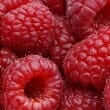Background
- Raspberry (Rubus idaeus) is cultivated and grows wild throughout temperate climates, including North America and Europe. For several centuries, midwives have used raspberry leaf to stimulate and ease labor. Tea made from raspberry leaves has been used for centuries as a folk medicine to treat wounds, diarrhea, colic pain and as a uterine relaxant. In Bulgaria, the leaves were used for stomach bleeds, diarrhea, vomiting, menstrual problems, and respiratory diseases. In traditional Tibetan medical practices, the fruit and leaves of raspberry are made into an extract or decoction and used as a cure for emotional disturbances, exhaustion, irritability, and chronic infections.
- The raspberry fruit is also commonly used as a flavoring, coloring, or food, either fresh or processed into cordials, jams, or preserves. The fruit is also commonly consumed for its antioxidants. Raspberry flowers have also been used for pimples, hemorrhoids, malaria, and as a poultice for eye inflammations.
- Raspberry leaf is used during pregnancy and labor today, but there are few studies supporting this use. Raspberry may also be useful in cancer treatment or prevention, or as an antimicrobial. More research is needed to confirm these findings.
- In the early 1990s, raspberries imported to the United States from Guatamala were infected with the Cyclospora parasite, which caused adverse effects such as fatigue, muscle aches, vomiting and diarrhea. Periodic outbreaks of the Cyclosporia parasite from imported raspberries continued throughout the next decade. In response to outbreaks, the Centers for Disease Control placed periodic bans on imported raspberries.
References
- Bagchi D, Roy S, Patel V, et al. Safety and whole-body antioxidant potential of a novel anthocyanin-rich formulation of edible berries. Mol.Cell Biochem. 2006;281(1-2):197-209.
View Abstract - Bagchi D, Sen CK, Bagchi M, et al. Anti-angiogenic, antioxidant, and anti-carcinogenic properties of a novel anthocyanin-rich berry extract formula. Biochemistry (Mosc.) 2004;69(1):75-80, 1.
View Abstract - Beekwilder J, Jonker H, Meesters P, et al. Antioxidants in raspberry: on-line analysis links antioxidant activity to a diversity of individual metabolites. J Agric.Food Chem 5-4-2005;53(9):3313-3320.
View Abstract - Kahkonen MP, Hopia AI, Heinonen M. Berry phenolics and their antioxidant activity. J Agric.Food Chem 2001;49(8):4076-4082.
View Abstract - Kowalczyk E, Krzesinski P, Fijalkowski P, et al. [The use of anthocyanins in the treatment of cardiovascular diseases]. Pol.Merkuriusz.Lek. 2005;19(109):108-110.
View Abstract - Liu M, Li XQ, Weber C, et al. Antioxidant and antiproliferative activities of raspberries. J Agric.Food Chem 5-8-2002;50(10):2926-2930.
View Abstract - Marzban G, Mansfeld A, Hemmer W, et al. Fruit cross-reactive allergens: a theme of uprising interest for consumers' health. Biofactors 2005;23(4):235-241.
View Abstract - Morillas-Ruiz J, Zafrilla P, Almar M, et al. The effects of an antioxidant-supplemented beverage on exercise-induced oxidative stress: results from a placebo-controlled double-blind study in cyclists. Eur J Appl Physiol 2005;95(5-6):543-549.
View Abstract - Mullen W, Lean ME, Crozier A. Rapid characterization of anthocyanins in red raspberry fruit by high-performance liquid chromatography coupled to single quadrupole mass spectrometry. J Chromatogr.A 8-9-2002;966(1-2):63-70.
View Abstract - Nohynek LJ, Alakomi HL, Kahkonen MP, et al. Berry phenolics: antimicrobial properties and mechanisms of action against severe human pathogens. Nutr Cancer 2006;54(1):18-32.
View Abstract - Proteggente AR, Pannala AS, Paganga G, et al. The antioxidant activity of regularly consumed fruit and vegetables reflects their phenolic and vitamin C composition. Free Radic.Res 2002;36(2):217-233.
View Abstract - Puupponen-Pimia R, Nohynek L, Hartmann-Schmidlin S, et al. Berry phenolics selectively inhibit the growth of intestinal pathogens. J Appl.Microbiol. 2005;98(4):991-1000.
View Abstract - Rice-Evans. The Antioxidant Activity of Regularly Consumed Fruit and Vegetables Reflects their Phenolic and Vitamin C Composition. Free Radical Research 2002;36(2):217-233.
- Wang SY, Lin HS. Antioxidant activity in fruits and leaves of blackberry, raspberry, and strawberry varies with cultivar and developmental stage. J Agric.Food Chem 2000;48(2):140-146.
View Abstract - Zafrilla P, Ferreres F, Tomas-Barberan FA. Effect of processing and storage on the antioxidant ellagic acid derivatives and flavonoids of red raspberry (Rubus idaeus) jams. J Agric.Food Chem. 2001;49(8):3651-3655.
View Abstract







